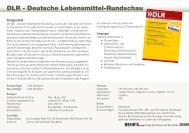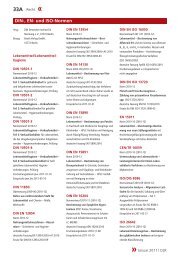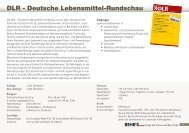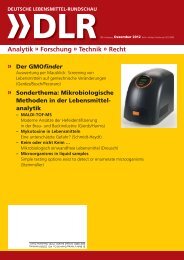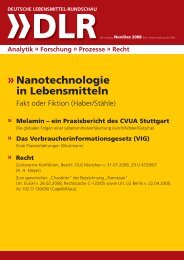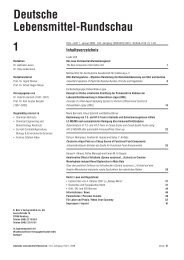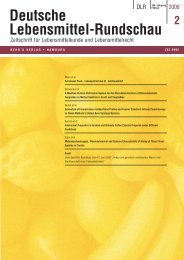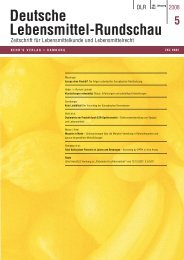Recht - DLR Online
Recht - DLR Online
Recht - DLR Online
Erfolgreiche ePaper selbst erstellen
Machen Sie aus Ihren PDF Publikationen ein blätterbares Flipbook mit unserer einzigartigen Google optimierten e-Paper Software.
68) Haila KM et al.: Carotenoid reaction with free radicals in acetone and toluene<br />
at different oxygen partial pressures. An ESR spin trapping study of<br />
structure-activity relationships. Z Lebensm Unters Forsch A 204, 81–87<br />
(1997).<br />
69) Jimenez-Escrig A et al.: Evaluation of free radical scavenging of dietary<br />
carotenoids in the stable radical 2,2-diphenyl-1-picrylhydrazyl. J Sci<br />
Food Agr 80 (11), 1686–1690 (2000).<br />
70) Howard LR et al.: Changes in phytochemical and antioxidant activity of<br />
selected pepper cultivars (Capsicum spp.) as influenced by maturity. J<br />
Agr Food Chem 48 (5), 1713–1720 (2000).<br />
71) Lee JJ et al.: Impact of genetic and environmental variation on development<br />
of flavonoids and carotenoids in pepper (Capsicum spp.). Sci<br />
Hortic 106 (3), 341–352 (2005).<br />
72) Marin A et al.: Characterization and quantitation of antioxidant constituents<br />
of sweet pepper (Capsicum annuum L.). J Agr Food Chem 52 (12),<br />
3861–3869 (2004).<br />
73) Rosa A et al.: Antioxidant activity of capsaicinoids. J Agr Food Chem 50<br />
(25), 7396–7401 (2002).<br />
74) Buckenhüskes H: Tomatenpaprika. Ind Obst Gemüseverw 74 (7), 230–<br />
239 (1989).<br />
75) Teuscher E: Gewürzdrogen, p. 146. Wissensch. Verlagsges. mbH Stuttgart<br />
(2003).<br />
76) Perez-Galvez A, Hornero-Mendez D, Minguez-Mosquera MI: Changes<br />
in the carotenoid metabolism of Capsicum fruits during application of<br />
modelized slow drying process for paprika production. J Agr Food Chem<br />
52 (3), 518–522 (2004) und Eur Food Res Technol 221 (5), 645–652<br />
(2005).<br />
77) Cardenosa R et al.: On-line HPLC detection of tocopherols and other antioxidants<br />
through the formation of a phosphomolybdenum complex. J<br />
Agr Food Chem 50 (12), 3390–3395 (2002)<br />
78) Chen SL, Gutmanis F: Autoxidation of extractable color pigments in chili<br />
pepper with special reference to ethoxyquin treatment. J Food Sci 33,<br />
274–280 (1968).<br />
79) Osuna-Garcia JA, Wall MM, Waddell CA: Natural antioxidants for preventing<br />
color loss in stored paprika. J Food Sci 62 (5), 1017–1021 (1997).<br />
80) Perfetti GA, Warner CR, Fazio T: High pressure liquid chromatographic<br />
determination of ethoxyquin in paprika and chili powder. J AOAC 64 (6),<br />
1453–1456 (1981).<br />
81) Vinas P, Hernandez Cordoba M, Sanchez-Pedreno C: Determination of<br />
ethoxyquin in paprika by high-performance liquid chromatography. Food<br />
Chem 42 (3), 241–251 (1991).<br />
EIN STÜCK ALLTAGSKULTUR<br />
Die Currywurst<br />
„... ’n Happen auf die Schnelle“<br />
In der Geschichte so mancher Nahrungsmittel spiegeln sich<br />
durchaus Zeitgeist und dementsprechend ein bestimmtes<br />
Image wider. Geradezu als Inbegriff (essbarer) Alltagskultur<br />
gilt die Currywurst, die sich allen Skeptikern der „Fast<br />
Food-Kultur“ zum Trotz zu einem der beliebtesten Gerichte<br />
an Imbissständen in ganz Deutschland entwickelt hat. Von<br />
einer „Ikone der Alltagskultur“ spricht denn auch der Internet-Informationsdienst<br />
Wikipedia ein wenig pathetisch.<br />
82) Kleinhenz S: Entwicklung einer LC/MS-Methode zum Quantifizieren von<br />
Sudanfarbstoffen in geringsten Mengen. Kolloquium am 27.September<br />
2006: Die Analyse von Spurenelementen und Schadstoffen in Lebensmitteln.<br />
Proceedings, p. 12. Bundesforschungsanstalt für Ernährung und<br />
Lebensmittel, Kulmbach (2006).<br />
83) Oberdieck, R.: Paprika. Fleischwirtschaft 68 (9), 1086–1096 (1988).<br />
84) Govindarajan VS: Capsicum, Part 3. Chemistry of the color, aroma, and<br />
pungency stimuli. CRC Crit Rev Food Sci Nutr 24 (3), 245–355 (1986).<br />
85) Luning PA, et al.: Gas chromatography, mass spectrometry, and sniffing<br />
port analysis of volatile compounds of fresh bell peppers (Capsicum<br />
annuum) at different ripening stages. J Agr Food Chem 42 (4), 977–983<br />
(1994) und Luning PA, Yuksel D, Roozen JP: Trends in flavour research.<br />
7th Weurman flavour research symposium, Noordwijkerhout, Netherlands,<br />
15.–18. June 1993. Proceedings, pp. 241–248 (1993).<br />
86) Pino J, Sauri-Duch E, Marbot R: Changes in volatile compounds of Habanero<br />
chile pepper (Capsicum chinense Jacq. cv. Habanero) at two ripening<br />
stages. Food Chem 94 (3), 394–398 (2006).<br />
87) Vidal Aragon MC, Lozano M, Montero de Espinosa V: Evolution of the<br />
aromatic fraction in red pepper for paprika during La Vera region traditional<br />
drying process. J. Food Qual 28 (3), 211–221 (2005).<br />
88) Lee JH et al.: Effect of gamma-irradiation on color, pungency, and volatiles<br />
of Korean red pepper powder. J Food Sci 69 (8), 585–592 (2004).<br />
89) Cichewicz RH, Thorpe PA: The antimicrobial properties of chile peppers<br />
(Capsicum species) and their uses in Mayan medicine. J Ethnopharmacol<br />
52 (2), 61–70 (1996). ISSN 0378-8741<br />
90) Surh YJ, Lee SS: Capsaicin in hot chili pepper: carcinogen, co-carcinogen<br />
or anticarcinogen? Food Chem Toxicol 34 (3), 313–316 (1996).<br />
91) Astorg P: Food carotenoids and cancer prevention, an overview of current<br />
research. Trends Food Sci Technol 8, 406–413 (1997).<br />
92) Perez-Galvez A et al.: Incorporation of carotenoids from paprika oleoresin<br />
into human chylomicrons. Brit J Nutr 89 (6), 787–793 (2003).<br />
93) Ahuja KDK, et al.: Effects of capsaicin, dihydrocapsaicin, and curcumin<br />
on copper-induced oxidation of human serum lipids. J Agr Food Chem<br />
54 (17), 6436–6439 (2006).<br />
94) Ahuja KDK, Ball MJ: Effects of daily ingestion of chilli on serum lipoprotein<br />
oxidation in adult men and women. Brit J Nutr 96 (2), 239–242<br />
(2006).<br />
95) Srinivasan, K.: Spices as influencers of body metabolism, an overview of<br />
three decades of research. Food Res Int 38 (1), 77–86 (2005).<br />
Irene Krauß<br />
Spieglerstr. 6, D-79713 Bad Säckingen<br />
Mag sein, dass der Vergleich etwas hoch gegriffen erscheint,<br />
aber er erklärt sich sicherlich aus der zentralen Rolle, welche<br />
die Currywurst welche in der deutschen Kultur- und<br />
Gesellschaftsgeschichte spielt.<br />
Bis sie seit den 1980er Jahren zunehmend Konkurrenz durch<br />
den Hamburger und vor allem durch den Döner – den mittlerweile<br />
beliebtesten deutschen Schnellimbiss – bekam, war<br />
436 ı Originalarbeiten Deutsche Lebensmittel-Rundschau ı 104. Jahrgang, Heft 9, 2008




